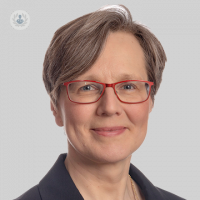Medically unexplained visual symptoms – the eyes and the mind
Written in association with:Children may experience problems with their eyes and vision which are sometimes difficult to explain. Often, these symptoms occur when children are worried or anxious about something – other children at school, a difficult time at home, periods of exam stress, or similar events. Typical vision problems include blurred vision, tunnel vision, double vision, or seeing coloured lights or shapes. Dr Annegret Dahlmann-Noor, an experienced ophthalmologist, explains the unexplainable!

What happens at the eye appointment?
The ophthalmologist (eye doctor) will take a full history, and may ask about worries at school or at home. Young children will be assessed by orthoptists, health professionals trained in assessing vision and eye movements in children. Sometimes children who complain of blurred vision actually have normal vision on the orthoptic tests, which can be of great reassurance to their parents and carers.
The ophthalmologist will then examine the eyes and carry out a test for glasses. If all these tests are normal, some children may have specialised tests which check whether the retina, the thin layer at the back of the eye which turns light into electrical signals, and the optic nerve, which takes the visual information to the brain, are working normally. Some children may also have an MRI scan of their eye sockets and brain.
If all is normal, a diagnosis of “medically unexplained visual symptoms” is very likely. The eye doctor will explain to the child and their family that there is no physical problem with the eyes and vision, and that for unknown reasons, the mind is not processing the visual information as well as it should. Fortunately, these problems very nearly always resolve on their own.
Will these medically unexplained visual symptoms go away?
Usually everything returns to normal within a few weeks, sometimes even within a few days of the eye tests. Sometimes it can take longer for the symptoms to resolve. Rarely, the problem can persist, but as families feel confident that there is no physical problem, they provide the reassurance that the child needs, and the children just move on and put their eye problem aside. This is a perfectly acceptable way of dealing with this issue, just as you would deal with the occasional tummy ache.
Very rarely, children can also develop other symptoms, such as tummy aches, headaches, numbness of hands or feet, or difficulties with walking. These require an assessment by a paediatrician to make sure that there are no physical causes for these problems either. If this assessment is normal, then a diagnosis of “medically unexplained symptoms” can be made. The management is the same as for the visual problems: the child needs reassurance that all is well, and that they can get on with their usual activities.
If there are underlying factors such as difficulties at school, a bereavement or other significant events, it can be helpful for the child and for the family to see a mental health professional such as counsellor, a clinical psychologist or a psychiatrist, who can provide the support that is needed to cope with stressful and unsettling situations.
If you would like more information, make an appointment with a specialist.


